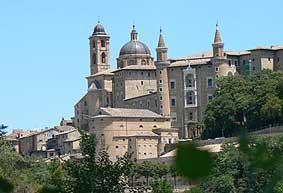


All the structures

The province of Pesaro and Urbino in Le Marche overlooks the Adriatic Sea, and is a central point between Emilia Romagna, the Republic of San Marino, the province of Ancona, the Umbrian province of Perugia and the Tuscan province of Arezzo.
A famous Pesaro and Urbino seaside town is Gabicce a Mare, also San Costanzo, Mondolfo, Pesaro and Fano. The inland area is characterized by the peaks of the Umbria-Marche Apennines.
The city of Pesaro lies at the mouth of the del Foglia valley. Visit Rocca Costanza in the old part of Pesaro and the Piazza del Popolo in the centre. The port-canal from the seventeenth century, renovated in 1857, is still important for fishing and local trade. Pesaro is traditionally known for its ceramics production (especially majolica) and silk processing.
Urbino, a UNESCO World Heritage site and a city of lively university activities, is located in a panoramic position between the Metauro and Foglia river valleys. A Renaissance city, it was the home of two major artists: Donato Bramante and Raphael. Worth visiting are the Palazzo Ducale and the Galleria Nazionale delle Marche, two of Urbino’s jewels. The house where Raphael was born is also beautiful.
Fano is certainly one of the most popular seaside resorts in the province of Pesaro and Urbino. A cathedral city, Fano was also an important Roman colony.
One of the most authentic villages in the province of Pesaro and Urbino is the beautiful village of Cagli. Cagli has an ancient history; in fact, it is located on the Via Flaminia, the most important consular road. Cagli’s development was also due to the ancient traditions of woollen cloth making and tanning leather. In the environs of Cagli there are various Roman remains along the prestigious Via Flaminia.
Tragic love story enthusiasts should visit Gradara.
Gradara is still surrounded by fourteenth century walls and towers that reach the fortress. The mighty castle rises above the city, with some rooms inside dedicated to Dante’s tragic love story of Paolo and Francesca.
Urbania is situated among the hills of Montefeltro. The Palazzo Ducale, the Town Hall, the Bishop’s Palace and the Cathedral of S. Christopher are some of Urbania’s artistic marvels. An unusual feature of Urbania that attracts adult tourists is the cemetery of the Mummies, located in the church of the Dead.